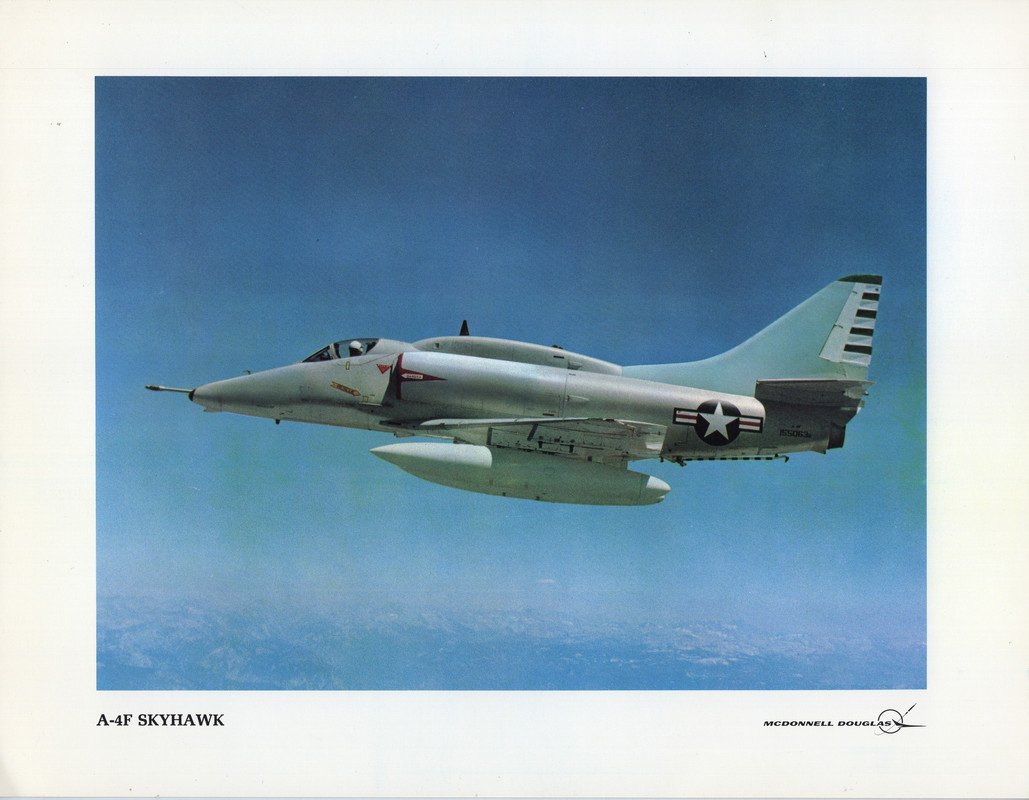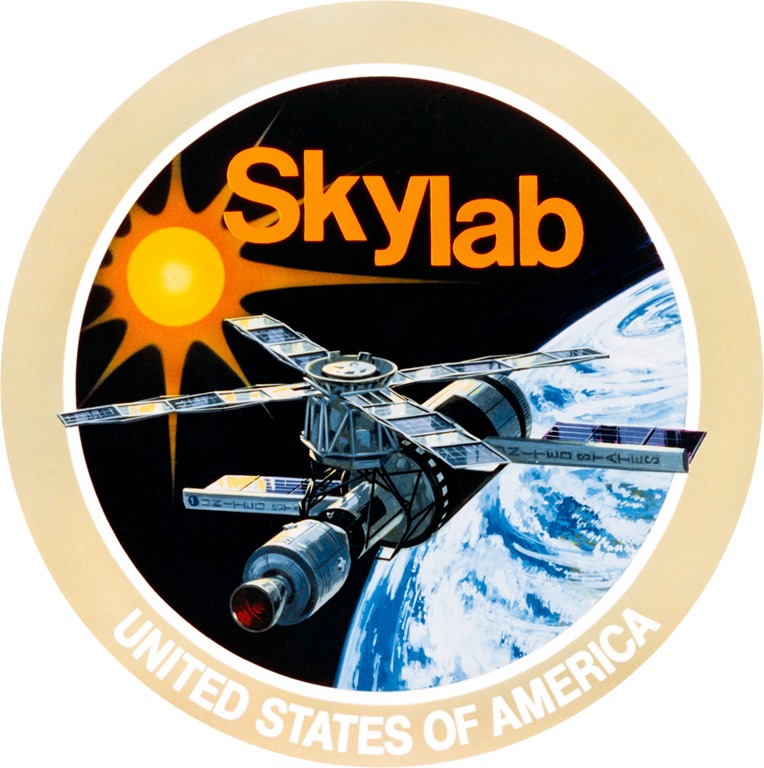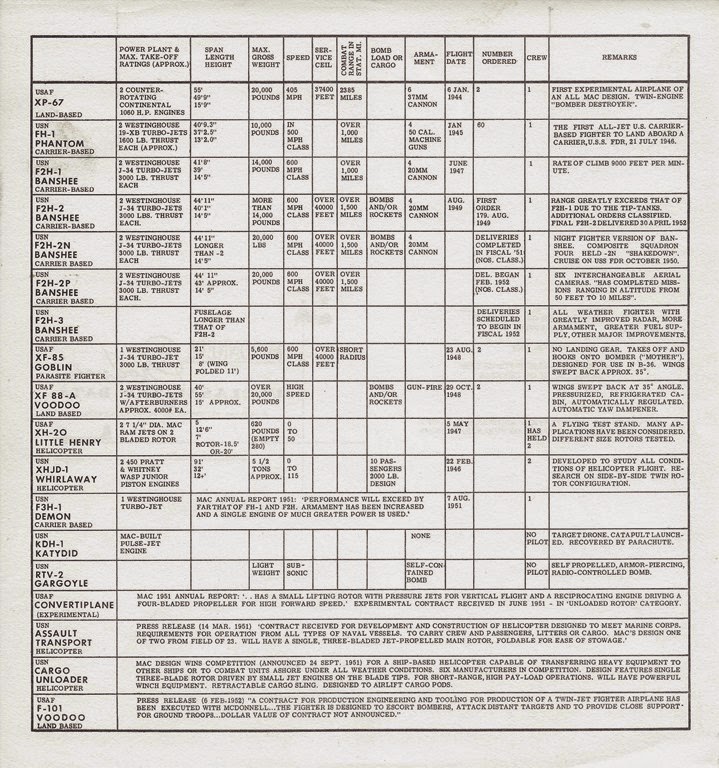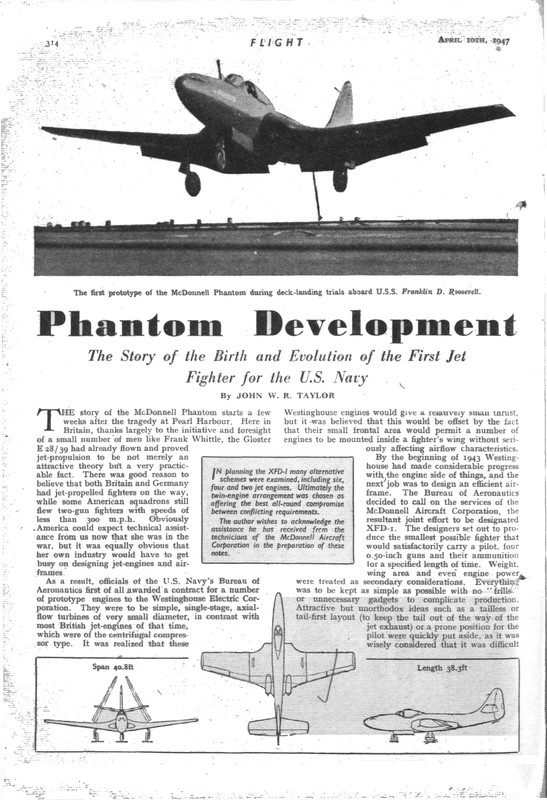 A nice brief artile on the Hughes H-4 Hercules’ first flight. From the November 2007 Boeing Frontiers Magazine.
A nice brief artile on the Hughes H-4 Hercules’ first flight. From the November 2007 Boeing Frontiers Magazine.
Friday, May 30, 2025
Hughes H-4 Hercules Article
Thursday, May 29, 2025
Strike Leader F-4 Poster
 A very nice early poster from McDonnell Aircraft introducing the F-4 Phantom II aircraft. From early 1960’s.
A very nice early poster from McDonnell Aircraft introducing the F-4 Phantom II aircraft. From early 1960’s.
Friday, May 23, 2025
Update!
I will be gone next week for a few days as it is my 58th wedding anniversary!
So, we are going away for a few days.
Ron
MDC (Douglas) Lithographs
 A number of MDC lithograghs of Douglas commercial and military aircraft. Three views and specs on rear. Circa 1968.
A number of MDC lithograghs of Douglas commercial and military aircraft. Three views and specs on rear. Circa 1968.
Thursday, May 22, 2025
AGM-84 Harpoon Missile Brochure #2
 A McDonnell Douglas Astronautics Company brochure for the AGM-84 Harpoon Missile. Lot’s of company aircraft and missile side views. Dated 1996.
A McDonnell Douglas Astronautics Company brochure for the AGM-84 Harpoon Missile. Lot’s of company aircraft and missile side views. Dated 1996.
Wednesday, May 21, 2025
Development History of the McDonnell FD-1/FH-1 Phantom (Reblog)
 A written history of the McDonnell FD-1/FH-1 Phantom aircraft. This report was prepared by the Historian’s office of the Naval Air Systems Command. Credit: Greater St. Louis Air and Space Museum
A written history of the McDonnell FD-1/FH-1 Phantom aircraft. This report was prepared by the Historian’s office of the Naval Air Systems Command. Credit: Greater St. Louis Air and Space Museum
Tuesday, May 20, 2025
B-47 Drogue Chute at Wright-Patterson Photos
 From Bill Kuhlman: “I ran across some photos of the Boeing B-47 drogue chute testing done at Wright-Patterson Air Force Base. The need for and use of a drogue chute is well explained on the Boeing B-47 Wikipedia page My father was involved in this testing as an Aerodynamic Development Engineer from June 1950 to March 1953. In addition to nine sequenced photos of the test B-47 landing, there's a copy of a Pioneer Parachute advert showing both the drogue and ribbon parachutes used, plus a photo of the ribbon 'chute in the wind tunnel.” Credit: Bill Kuhlman
From Bill Kuhlman: “I ran across some photos of the Boeing B-47 drogue chute testing done at Wright-Patterson Air Force Base. The need for and use of a drogue chute is well explained on the Boeing B-47 Wikipedia page My father was involved in this testing as an Aerodynamic Development Engineer from June 1950 to March 1953. In addition to nine sequenced photos of the test B-47 landing, there's a copy of a Pioneer Parachute advert showing both the drogue and ribbon parachutes used, plus a photo of the ribbon 'chute in the wind tunnel.” Credit: Bill Kuhlman
Monday, May 19, 2025
Douglas Aircraft Markings and 3-View Drawings (Reblog)
 Markings and 3-View drawings of the Douglas F3D, F4D, A2D (Skyshark) and AD-1/-6 aircraft. From late 1990’s Modelist-Konstruktor magazines.
Markings and 3-View drawings of the Douglas F3D, F4D, A2D (Skyshark) and AD-1/-6 aircraft. From late 1990’s Modelist-Konstruktor magazines.
Friday, May 16, 2025
Douglas A2D Skyshark(Reblog)
 I love odd aircraft and the Douglas A2D fits that bill. Here are 46 photos for your pleasure!
I love odd aircraft and the Douglas A2D fits that bill. Here are 46 photos for your pleasure!
Thursday, May 15, 2025
Douglas A2D-1 Skyshark 3-View Drawing(Reblog)
 An exellent 3-View drawing of the Douglas A2D-1 Skyshark aircraft. From the September 1985 Aviation News magazine "Warpaint" series. Drawings by Mike Keep. (I added another 3-view and photo.)
An exellent 3-View drawing of the Douglas A2D-1 Skyshark aircraft. From the September 1985 Aviation News magazine "Warpaint" series. Drawings by Mike Keep. (I added another 3-view and photo.)
Wednesday, May 14, 2025
Mr. MAC’s Helicopters–Part I (Reblog)
 A nice report on the McAir helicopter projects from 1939 t0 1960. Written by Fred Roos and first presented at the AIAA conforence in January 2003.
A nice report on the McAir helicopter projects from 1939 t0 1960. Written by Fred Roos and first presented at the AIAA conforence in January 2003.
Tuesday, May 13, 2025
The Blue Angels Booklet(Reblog)
 The 1975 booklet on the Blue Angels demonstration team. Lots of nice photos.
The 1975 booklet on the Blue Angels demonstration team. Lots of nice photos.
Monday, May 12, 2025
McDonnell Douglas SkyLab Photos(Reblog)

 Some photos and illustrations that I have of the Skylab. I worked on this project twice. Once on how to correct and mitigate the solar array damage and secondly in design engineering finding all of the flammable items and materials (Think Apollo1fire).
Some photos and illustrations that I have of the Skylab. I worked on this project twice. Once on how to correct and mitigate the solar array damage and secondly in design engineering finding all of the flammable items and materials (Think Apollo1fire).
Skylab was a space station launched and operated by NASA, the space agency of the United States. Skylab orbited the Earth from 1973 to 1979, and included a workshop, a solar observatory, and other systems. It was launched unmanned by a modified Saturn V rocket, with a mass of 169950 pounds (77 MT). Three manned missions to the station, conducted between 1973 and 1974 using the Apollo Command/Service Module (CSM) atop the smaller Saturn IB, each delivered a three-astronaut crew.
Friday, May 9, 2025
F-3H-G Report and Photos(Reblog)

 “The design of what was eventually to emerge as the McDonnell F-4 Phantom began in August of 1953. The McDonnell design team was headed by Herman Barkley. Initially, the goal of the team was to extend the production life of the F3H Demon single-seat carrier-based fighter by boosting its performance and improving its versatility.
“The design of what was eventually to emerge as the McDonnell F-4 Phantom began in August of 1953. The McDonnell design team was headed by Herman Barkley. Initially, the goal of the team was to extend the production life of the F3H Demon single-seat carrier-based fighter by boosting its performance and improving its versatility.
Several quite different design concepts emerged, all of them being informally designated by the company as F3H-X since they were all viewed as a natural follow-on to the F3H Demon.
The first of these preliminary designs was the F3H-C or the "Super Demon". The F3H-C was to be powered by a single Wright J67 turbojet and was to be capable of reaching Mach 1.69 at high altitude. The J67 was a license-built version of the British-built Bristol Olympus turbojet engine, and was untried and unproven at the time.
The F3H-E project (also known as Model 98A by the company) was similarly powered, but dispensed with the nose-high attitude of the Demon and stood level on a tricycle undercarriage. It had a 45-degree swept wing of 450 square feet in area. In the event, the J67 engine never did materialize as a realistic powerplant for American aircraft.
The Model 98B (F3H-G) project was to be powered by a pair of Wright J65-W-2 (or W-4) turbojets rated at 7800 lb.s.t. each. The twin-engined configuration was attractive to many in the Navy, because of the increased amount of safety it offered over a single-engined aircraft. The engines were to be fed by a pair of side-mounted air intakes. A low-mounted swept wing and an all-flying straight tailplane were to be used. This wing was slightly larger than that of the F3H-E, with a 530-square foot area. The fuselage was to be designed in conformance with the area rule, in order that minimum transonic drag be achieved.
The F3H-G aircraft was to be equipped with an Aero 11B fire control system and an AN/APQ-150 radar. Armament was to consist of four 20-mm cannon, but provision for a retractable pack carrying 56 two-inch FFAR rockets was also proposed. A heavy load of bombs and fuel tanks could be carried on up to nine external stores stations (four under each wing and one underneath the fuselage). A maximum speed of Mach 1.52 was envisaged.
The J65 was a license-built version of the British-designed Armstrong Siddeley Sapphire engine, and was already in production at the time. Although at that time the Navy was experiencing a good deal of trouble with the J65 engine installed in its North American FJ-3 Fury single-engined fighter, the McDonnell team fully expected that these problems would be resolved by the time that their F3H-G proposal was ready for production.
The F3H-H was similar in overall configuration to the F3H-G, but was to be powered by a pair of higher-thrust General Electric J79 turbojets. The J79 was at that time a new and untried engine. Assuming that the J79 performed as promised, a maximum speed of Mach 1.97 was envisaged.
The Model 98F was the photographic reconnaissance version of the Model 98C.
Models 98C and D were to be fitted respectively with delta and straight wings, and were to be powered either by a pair of Wright J65s or two J79s.
The Model 98E (F3H-J) was to have been similar to Models 98C and D, but with a larger and thinner delta wing.
Herman Barkley's design team decided that the Model 98B with its twin J65s offered the best potential and they abandoned work on all the other configurations. A full-sized mockup of the Model 98B (F3H-G) was built. The company hedged its bets by designing the right side of the mockup for a J79 engine and the left for a J65.
On September 19, 1953, McDonnell submitted its Model 98B project to the Navy's Bureau of Aeronautics (BuAer) in the form of an unsolicited proposal. Since the Navy as yet had no official requirement for such an aircraft, McDonnell tried to cover all bases by developing interchangeable single- and two-seat noses that could be accommodated to widely different roles. Noses were designed that could carry search radars, missile fire-control systems, mapping radars, cameras, or electronic reconnaissance equipment.
Although the Navy was favorably impressed by the Model 98B proposal, the Grumman XF9F-9 Tiger and the Vought XF8U-1 Crusader which had been ordered respectively in April and June of 1953 appeared to satisfy all the Navy's immediate requirements for supersonic fighters. Nevertheless, the Navy encouraged McDonnell to rework its design into a single-seat, twin-engined all-weather attack aircraft to compete against designs being worked on by Grumman and North American.
McDonnell submitted a formal development proposal for the F3H-G/H to the Navy in August of 1954. The Navy responded in October of 1954 by issuing a letter of intent for two prototypes and a static test aircraft. The Navy assigned the designation AH-1 to the project, reflecting its intended ground attack mission. The AH-1 was to have no less then eleven weapons pylons. Armament was to consist of four 20-mm cannon.
On December 14, 1954, the multirole mission of the aircraft was formally abandoned by the Navy, and McDonnell was requested to rework the proposal as an all-weather interceptor. McDonnell was instructed to remove the cannon and all hardpoints except for a centerline pylon for a 600-US gallon fuel tank. In addition, troughs were to be added for four Raytheon Sparrow semi-active radar homing air-to-air missiles. A Raytheon-designed APQ-50 radar was added, this installation being essentially that installed in the F3H-2 Demon. A second seat was added to accommodate a radar operator.
On April 15, 1955, in a formal letter from the BuAer to the Commander of Naval Operations, the J79 engine was formally adopted, and all work on the J65-powered version was dropped.” Credit: Secret Projects
Thursday, May 8, 2025
McDonnell Product Data Card 1939-1952 (Reblog)
 A copy of the McDonnell Aircraft product data card showing specifications of all the products from 1939-1952.
A copy of the McDonnell Aircraft product data card showing specifications of all the products from 1939-1952.
Wednesday, May 7, 2025
MDC Fighters for Today and Tomorrow (Reblog)
 A nice McDonnell Douglas 1983 company brochure showing fighters for today and the future. Good drawings and cut-a-ways.
A nice McDonnell Douglas 1983 company brochure showing fighters for today and the future. Good drawings and cut-a-ways.
Tuesday, May 6, 2025
Phantom Flyer Famous Fighters Article (Reblog)
 A copy of the May 1980 Phantom Flyer article by the McDonnell Scale Modelers’ Club on MDC fighters. By Bob Pukala, I believe. The cover photo is unique with three generation of fighters present! Lots of early aircraft photos.
A copy of the May 1980 Phantom Flyer article by the McDonnell Scale Modelers’ Club on MDC fighters. By Bob Pukala, I believe. The cover photo is unique with three generation of fighters present! Lots of early aircraft photos.
Monday, May 5, 2025
Flight Test F-101A Voodoo (Reblog)
 This is a Fight Test F-101A #12 (S/N 532429). Note the faired gun ports and number 12 on it’s nose.
This is a Fight Test F-101A #12 (S/N 532429). Note the faired gun ports and number 12 on it’s nose.
I looked at this photo maybe a half dozen times before I realized what I was seeing! The nose has an instrument photo panel in it, in order to record the in-flight data. This was the way it was done before data link came around!
Either a camera is placed in front of the panel to record the instruments or the camera shoots thru a hole in the panel into a mirror and records the data. It is hard to tell from this photo; but, it may have the center hole.
My first job in Flight Test was to calculate the required distance between the camera lens and the front of the instrument panel on F4H-1 # 8. So, this rare photo has special meaning to me.
Friday, May 2, 2025
McDonnell RF-101C Voodoo Walk Around (Pima)
 A Walk-a-Round of the RF-101C at Pima Air & Space Museum in Tucson, Arizona. Note: There are two walk-a-around sets of photos and a few TO 1-1-4 pages in the Zip file!
A Walk-a-Round of the RF-101C at Pima Air & Space Museum in Tucson, Arizona. Note: There are two walk-a-around sets of photos and a few TO 1-1-4 pages in the Zip file!
Thursday, May 1, 2025
McDonnell Phantom I (FH-1) Development Article
 A copy of the April 10 1947 article from Flight magazine on the Development of the McDonnell Phantom I (FH-1) aircraft. I added a 3-view drawing that I like.
A copy of the April 10 1947 article from Flight magazine on the Development of the McDonnell Phantom I (FH-1) aircraft. I added a 3-view drawing that I like.



